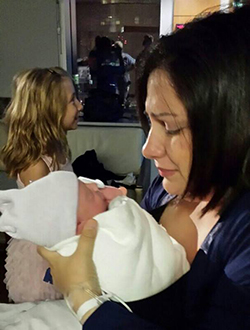Living in a suburb of Houston, Texas, hurricanes were commonly a threat, but seemed to be only something people worried about when they were breathing down our necks in the Gulf. Growing up in Houston, I would often see people panic about hurricanes, and then prepare, but only after we could feel the heavy mile per hour winds on our face. Hurricane Katrina changed all of that for many Houstonians. No one really knew the full extent of damage that Hurricane Katrina would cause, and as a consequence, even today, so many years later, the aftermath is evident. A few months later, when the threat of Hurricane Rita became a reality, thoughts of Hurricane Katrina’s devastation still ran rampant in our minds. Everyone seemed to prepare for the worse. And a lot of them hit the road all at once.
At the time, I was living with my parents while my husband was overseas. I was pregnant with my first child, and although I was twenty-five years old, I felt like I was fifteen. Everything about pregnancy was so foreign to me. I was not a nurse. I didn’t really know anything about pregnancy…I just knew women had been doing it for a long time. Luckily, my mother was a nurse.
When we were told we needed to evacuate, we knew where we were going to go. We had a plan. We weren’t expecting fuel to be so hard to find, but we evacuated with another family and pooled our resources together. We weren’t expecting it to take 17 hours to drive 160 miles inland, but we had enough water and food for the trip. And as a mass evacuation took place, we weren’t expecting to be stranded on Interstate 10, unable to go anywhere as millions of people also tried to fight their way out of Houston.
When we finally made it to our evacuation destination, my mom knew it was important to monitor my blood pressure. Throughout the last few months of my pregnancy I had developed high blood pressure, and as a nurse, she knew to be on the lookout for the signs and symptoms of preeclampsia. Preeclampsia is a condition caused by high blood pressure during or immediately after pregnancy that can cause many maternal and fetal complications and can also lead to eclampsia, which is the onset of seizures.
is a condition caused by high blood pressure during or immediately after pregnancy that can cause many maternal and fetal complications and can also lead to eclampsia, which is the onset of seizures.
For our family, we were able to return home shortly after we evacuated. But now, as a labor and delivery nurse, I often think about that time in my life. I don’t know what I would have done if I didn’t have a good support system around me. I don’t know what I would have done if my mother didn’t know that my blood pressure needed to be monitored, especially in times of high stress. I don’t know what I would have done if I would have been forced to deliver so far from home. Thankfully, because I had wonderful people who knew what to do around me and a few supplies, I’ll never have to find out.
The more you know about your pregnancy and the risks that are common in your area, the more effectively you’ll be able to plan for a disaster. It really helps to have a communications plan, make a kit, and keep a record of your prenatal care. For healthcare providers, taking care of pregnant women who do not have access to any prenatal records can be very dangerous. And now, as an obstetrical nurse, I understand how important it is to take care of yourself during pregnancy, maintain prenatal care, and above all else, have a plan.


